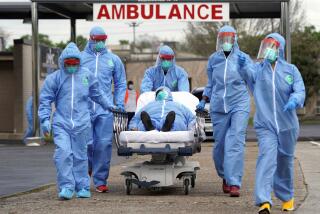How bad is COVID-19 where your child goes to college? Here’s where to look

- Share via
We’re answering readers’ questions about life during the pandemic:
Where can I find trustworthy statistics on how COVID-19 affects young adults?
When the University of Pennsylvania reversed its plans for in-person instruction on July 31, provost Wendell Pritchett wrote that “1.5 million new cases of COVID-19 have been confirmed in the United States, with the confirmed case count soaring from 2.4 million on June 25 to 3.9 million on July 22. This means that almost 40% of all confirmed COVID-19 cases in the United States since the beginning of the pandemic have been reported in the last month.”
In the announcement, the university linked to data compiled by the Johns Hopkins University Coronavirus Resource Center in reaching its decision. This information source is available to the public online and is considered among the most reliable and easy to understand for a layperson.
We’re listening, L.A.: Tell us what you want to know about the most pressing questions you have at this time — how to find a job, the best ways to manage your finances, and whether it’s safe to send your kids back to school or off to college — and we’ll find the best experts to answer your questions.
The site is a continuously updated source of COVID-19 data that aggregates and analyzes data from numerous outlets including the World Health Organization, Centers for Disease Control and Prevention and the COVID Tracking Project. The CRC also lists global and local numbers on COVID-19 cases, testing and contact tracing.
Parents who are concerned about community spread in college towns can use the Johns Hopkins University’s Center for Systems Science and Engineering’s interactive dashboard for detailed information on specific counties.
Last school year, you might have spent weeknights in a study room with poor circulation, surrounded by friends as you crammed for exams.
If your child is attending Rice University, for example, you would plug in “Texas” in the state drop-down category and “Houston” in the county, and instantly receive a comprehensive and downloadable “COVID-19 status report “ for that area. Confirmed cases and deaths in Houston are listed by race, ethnicity and age. The report also lists information on hospital and ICU beds, overall statistics for the state, and the number of cases in the last 14 days.
Similar information is available on the CDC website, which reports COVID-19 case counts, deaths and laboratory testing numbers daily by age, geography and race on its COVID Data Tracker.
Looking at the numbers can give parents a sense of how the county is doing in containing the coronavirus and help them in making a difficult decision.
We’re listening, L.A.: Tell us what you want to know about the most pressing questions you have at this time — how to find a job, the best ways to manage your finances, and whether it’s safe to send your kids back to school or off to college — and we’ll find the best experts to answer your questions.
More to Read
Sign up for The Wild
We’ll help you find the best places to hike, bike and run, as well as the perfect silent spots for meditation and yoga.
You may occasionally receive promotional content from the Los Angeles Times.













